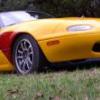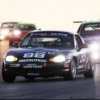#21

 Posted 05-27-2015 06:33 PM
Posted 05-27-2015 06:33 PM

The published reports on safety of seats appears to suggest that holding the body securely with a molded (and very strong) seat dramatically reduces injury. However the same is not the same with the head which MUST have some energy retardation. Few seats in a club racing car are molded and so we have a lot of movement under impact and as Todd has noted, we have little if any head level retardation protection on the left side of Spec Miata seats. NASCAR moved thier seats slightly to center line to allow this.
Regardless of all this, I drove past Lee before the impact and his car was on a bank. It seems likely to me that Willy's car experienced rapid vertical acceleration on impact. If Willy had data in his car (accelerometers) - and decided to show this publically when he has recovered, then we would know what loads the car experienced. If the data capture rate was fast enough...
CNJ


#22

 Posted 05-27-2015 06:50 PM
Posted 05-27-2015 06:50 PM

F1 and Indy have at least 2.5" of compressible impact materials under the but of the driver. That helps prevent the compression injuries.
Seems like a lot less in this F1 car cut-in-half video & PDF -
http://www.sauberf1t...Infographic.pdf
Chris
Happiness is a dry martini and a good woman ... or a bad woman.
- George Burns
#23

 Posted 05-27-2015 07:00 PM
Posted 05-27-2015 07:00 PM

Lees car is in my possession. Both door bars are shaped like a banana. Lower bar ripped free of the main hoop taking a chunk with it. Upper bar pushed halfway thru the main hoop as expected because of angled design. Hit was below lower bar and unusual for us because lees car was nose high stuck on a bank. Rocker sill is almost touching the ground with 4.5 inch clearance at edges of front and rear. I'll point out cage was not designed for this type of upward hit. Hit and damage was made worse because of the car being dug in the mud.
I stopped and looked at it on my way home today. Now I understand better.
The issue looks like the #8 car penetrated the seam between the lower door bar and the rocker panel. Essentially, it rode up on the rocker panel and wedged its way between the lower bar and the rocker panel. Attaching the lower bar to the rocker panel would effectively make the rocker panel part of the door bars and essentially ensure that the incoming car is caught by the steel net that is the door bars.
I think the trick in that configuration would be ensuring that the welds to the rocker panel are strong enough to withstand the severe sheer forces in an impact of that magnitude.
Looking at those door bars makes me want to go back and add lots of saddle gussets to the joints in mine.
-tch
Build: www.tomhampton.info
video: vimeo.com/tomhampton
Support: X-Factor Racing
I didn't lose, I just got outspent!



#24

 Posted 05-27-2015 07:16 PM
Posted 05-27-2015 07:16 PM

3 podium finishes
2 2013 NASA nats
1 2013 Scca runoffs







#25

 Posted 05-27-2015 08:50 PM
Posted 05-27-2015 08:50 PM

To be clear, i was not criticizing you cage install, but rather my own. Seeing the amount of bending and twisting that is present in that wreck...is eye opening.
The video does not show how much the door bars moved, twisted, and bent very well. The lower bar penetrates to the midline of the passenger footbox. The upper door bar bent in to the plane of the eyeball vent, and is in an S shape. As the upper bar was straightened, it pushed the front hoop and main hoop apart, which caused the main hoop to bent aft-ward.
Ultimately, the cage did its job.
-tch
Build: www.tomhampton.info
video: vimeo.com/tomhampton
Support: X-Factor Racing
I didn't lose, I just got outspent!



#26

 Posted 05-27-2015 09:40 PM
Posted 05-27-2015 09:40 PM

We use a hans (aka shoulder harness bar) at the correct angle to reduce spinal compression. It sounds like maybe Willie's shoulder harnesses angled too far down behind the seat and caused spinal compression. I hope someone can shed light on this because this may be the most critical lesson of all here. Need details.
For the camera car I think the thing to recognize is that the lower pass side door bar was designed straight (nothing wrong with that), not bent out into the door, so I don't see major additional intrusion from the post incident screen grabs (have not seen car in person). I don't believe any of the major builders have a driver side lower bar configured like this pass side was. So this isn't indicative of what would happen on driver side with two door bars bent outward into the door.
Full disclosure: SMAC chairman, my opinions do not reflect anything to do with the SMAC unless specifically stated.
Todd Lamb
Atlanta Speedwerks
www.atlspeedwerks.com
SpeedShift Transmissions - reliability and performance
Spec Miata / Spec Boxster / Spec Cayman specialist
Spec MX-5 Challenge Series Director
Global MX-5 Cup team











#27

 Posted 05-27-2015 09:52 PM
Posted 05-27-2015 09:52 PM

3 podium finishes
2 2013 NASA nats
1 2013 Scca runoffs







#28

 Posted 05-27-2015 10:32 PM
Posted 05-27-2015 10:32 PM

We saddle gusset all our main joints. We also use large floor plates so nothing can tear away. Neither of these things would have made a difference in the TWS camera car.
We use a hans (aka shoulder harness bar) at the correct angle to reduce spinal compression. It sounds like maybe Willie's shoulder harnesses angled too far down behind the seat and caused spinal compression. I hope someone can shed light on this because this may be the most critical lesson of all here. Need details.
For the camera car I think the thing to recognize is that the lower pass side door bar was designed straight (nothing wrong with that), not bent out into the door, so I don't see major additional intrusion from the post incident screen grabs (have not seen car in person). I don't believe any of the major builders have a driver side lower bar configured like this pass side was. So this isn't indicative of what would happen on driver side with two door bars bent outward into the door.
sorry, i didnt mean to imply that saddle gussets would have made a difference here---as the dont change the tubing strength. the welds held. My intent was that given the degree of bending and obvious stresses incurred here, i didn't want to rely on just welded joints, because of the potential consequence if one or more of these joints fails.
-tch
Build: www.tomhampton.info
video: vimeo.com/tomhampton
Support: X-Factor Racing
I didn't lose, I just got outspent!



#29

 Posted 05-28-2015 05:01 AM
Posted 05-28-2015 05:01 AM

Full disclosure: SMAC chairman, my opinions do not reflect anything to do with the SMAC unless specifically stated.
Todd Lamb
Atlanta Speedwerks
www.atlspeedwerks.com
SpeedShift Transmissions - reliability and performance
Spec Miata / Spec Boxster / Spec Cayman specialist
Spec MX-5 Challenge Series Director
Global MX-5 Cup team











#30

 Posted 05-28-2015 05:05 AM
Posted 05-28-2015 05:05 AM

www.schroth.com/installation-instructions/en/03_anchorage_locations_and_geometries.htm
Full disclosure: SMAC chairman, my opinions do not reflect anything to do with the SMAC unless specifically stated.
Todd Lamb
Atlanta Speedwerks
www.atlspeedwerks.com
SpeedShift Transmissions - reliability and performance
Spec Miata / Spec Boxster / Spec Cayman specialist
Spec MX-5 Challenge Series Director
Global MX-5 Cup team











#31

 Posted 05-28-2015 06:07 AM
Posted 05-28-2015 06:07 AM

Lees car is in my possession. Both door bars are shaped like a banana.
Lower bar ripped free of the main hoop taking a chunk with it.
Upper bar pushed halfway thru the main hoop as expected because of angled design.
Hit was below lower bar and unusual for us because lees car was nose high stuck on a bank. Rocker sill is almost touching the ground with 4.5 inch clearance at edges of front and rear. I'll point out cage was not designed for this type of upward hit. Hit and damage was made worse because of the car being dug in the mud.
Chris, curious questions with respect to potential learning.
Is there something to be learned from lower bar taking chunk with it. Presume main hoop parent material fractured some distance from the actual weld.
Does the upper bar pushed halfway thru the main hoop material show any main hoop material fracture away from the weld.
Understood, something fails under these impact conditions.
The metallurgy/welding folks could sift thru the responses to the above for potential future value.



#32

 Posted 05-28-2015 07:37 AM
Posted 05-28-2015 07:37 AM

I think the trick in that configuration would be ensuring that the welds to the rocker panel are strong enough to withstand the severe sheer forces in an impact of that magnitude.
This may be more difficult than anticipated. I'm not sure whether the rocker panels are plated (they are magnetic) and where the materials change from less rustable to more rustable, but as I was trying to pull some dents over the winter I found it very difficult to get a stud to stick on the underside for my dent puller, even after burnishing the surface with an angle grinder.



#33

 Posted 05-28-2015 12:02 PM
Posted 05-28-2015 12:02 PM

The original topic here asks what we can do to be safer...
Discussions like this serve that purpose well which is great.
My opinions are based on a litany of car builds and cage builds for myself or customers, and I typically get to see the car safety eventually get tested somehow. Not only SM, but other classes and rally, circletrack. Like many here, alot of years of club racing experiences show alot of things.
First and foremost, SCCA and NASA have to get out of "CYA" mode anytime there is an incident. All incidents should have a pictorial expose' shared and qualified comments or analysis discussed with club racers, especially in areas that may be subtle like belt angle or even the wrapping method. Our education of reality vs. theoretical would jump up the curve quickly. Instead, if the incident is serious, a tarp and yellow tape to keep people away is the first responsive. It is very offensive really, to every participant. The latest and by far the most serious incident I have been associated with at thunder hill had staff serving as crowd control attempting to prevent cell phone pictures before there was enough help for the driver on scene.
Second, everyone should realize that the SFI/FIA organizations are not in the business of finding the best safety equipment, rather the best safety equipment that will pay their licensing fees. This creates problems both ways - there are examples of great equipment that won't pay the fees, and there are examples of poorer equipment that will pay the fees. This is important because NASA and SCCA feel requiring the rating is some kind of liability insurance. I agree we need good standards, but in the conversation of "how to get safer" there are significant problems in this area.
Third, specifically to SM and to road racing, we need to decide how many fires we are having, and how big a problem that is. What is the propensity of fire causing incidents and how are they handled? This is important, because our rules base, which has evolved since the time when fires were common, are making tradeoffs in this area that are causing injury today.
The last thing I have time to add right now, is that I know of no one that pretends their SM is a street car. The cage rules we use started as showroom stock, where it had to be a bolt in cage in order not to stiffen the chassis, as that is "against class philosophy". Necessity stepped that up to a welded cage and a race seat, but with limited pickup points. Now that can include seat support structure that doesn't count as pickup points. We are the last class to have a pickup point limitation. We should not. We have a stiff car already with crappy shocks, so not only is more cage not going to increase the car handling at all, but even if it did it should be allowed.
My .02,
Kyle
- Ron Alan, Rob Burgoon, Diller and 1 other like this

#34

 Posted 05-28-2015 12:15 PM
Posted 05-28-2015 12:15 PM

The original topic here asks what we can do to be safer...
Discussions like this serve that purpose well which is great.
My opinions are based on a litany of car builds and cage builds for myself or customers, and I typically get to see the car safety eventually get tested somehow. Not only SM, but other classes and rally, circletrack. Like many here, alot of years of club racing experiences show alot of things.
First and foremost, SCCA and NASA have to get out of "CYA" mode anytime there is an incident. All incidents should have a pictorial expose' shared and qualified comments or analysis discussed with club racers, especially in areas that may be subtle like belt angle or even the wrapping method. Our education of reality vs. theoretical would jump up the curve quickly. Instead, if the incident is serious, a tarp and yellow tape to keep people away is the first responsive. It is very offensive really, to every participant. The latest and by far the most serious incident I have been associated with at thunder hill had staff serving as crowd control attempting to prevent cell phone pictures before there was enough help for the driver on scene.
Second, everyone should realize that the SFI/FIA organizations are not in the business of finding the best safety equipment, rather the best safety equipment that will pay their licensing fees. This creates problems both ways - there are examples of great equipment that won't pay the fees, and there are examples of poorer equipment that will pay the fees. This is important because NASA and SCCA feel requiring the rating is some kind of liability insurance. I agree we need good standards, but in the conversation of "how to get safer" there are significant problems in this area.
Third, specifically to SM and to road racing, we need to decide how many fires we are having, and how big a problem that is. What is the propensity of fire causing incidents and how are they handled? This is important, because our rules base, which has evolved since the time when fires were common, are making tradeoffs in this area that are causing injury today.
The last thing I have time to add right now, is that I know of no one that pretends their SM is a street car. The cage rules we use started as showroom stock, where it had to be a bolt in cage in order not to stiffen the chassis, as that is "against class philosophy". Necessity stepped that up to a welded cage and a race seat, but with limited pickup points. Now that can include seat support structure that doesn't count as pickup points. We are the last class to have a pickup point limitation. We should not. We have a stiff car already with crappy shocks, so not only is more cage not going to increase the car handling at all, but even if it did it should be allowed.
My .02,
Kyle
A literary award yes Jim?






#35

 Posted 05-28-2015 12:19 PM
Posted 05-28-2015 12:19 PM

The original topic here asks what we can do to be safer...
Discussions like this serve that purpose well which is great.
My opinions are based on a litany of car builds and cage builds for myself or customers, and I typically get to see the car safety eventually get tested somehow. Not only SM, but other classes and rally, circletrack. Like many here, alot of years of club racing experiences show alot of things.
First and foremost, SCCA and NASA have to get out of "CYA" mode anytime there is an incident. All incidents should have a pictorial expose' shared and qualified comments or analysis discussed with club racers, especially in areas that may be subtle like belt angle or even the wrapping method. Our education of reality vs. theoretical would jump up the curve quickly. Instead, if the incident is serious, a tarp and yellow tape to keep people away is the first responsive. It is very offensive really, to every participant. The latest and by far the most serious incident I have been associated with at thunder hill had staff serving as crowd control attempting to prevent cell phone pictures before there was enough help for the driver on scene.
Second, everyone should realize that the SFI/FIA organizations are not in the business of finding the best safety equipment, rather the best safety equipment that will pay their licensing fees. This creates problems both ways - there are examples of great equipment that won't pay the fees, and there are examples of poorer equipment that will pay the fees. This is important because NASA and SCCA feel requiring the rating is some kind of liability insurance. I agree we need good standards, but in the conversation of "how to get safer" there are significant problems in this area.
Third, specifically to SM and to road racing, we need to decide how many fires we are having, and how big a problem that is. What is the propensity of fire causing incidents and how are they handled? This is important, because our rules base, which has evolved since the time when fires were common, are making tradeoffs in this area that are causing injury today.
The last thing I have time to add right now, is that I know of no one that pretends their SM is a street car. The cage rules we use started as showroom stock, where it had to be a bolt in cage in order not to stiffen the chassis, as that is "against class philosophy". Necessity stepped that up to a welded cage and a race seat, but with limited pickup points. Now that can include seat support structure that doesn't count as pickup points. We are the last class to have a pickup point limitation. We should not. We have a stiff car already with crappy shocks, so not only is more cage not going to increase the car handling at all, but even if it did it should be allowed.
My .02,
Kyle
Fantastic post.



#36

 Posted 05-28-2015 12:22 PM
Posted 05-28-2015 12:22 PM

I agree with Kyle.
I have spent a lot of time in my years on the ASAC and the CRB, fighting to eliminate restrictions on roll cages. Why would be restrict the number of attach points and why would be mandate a cage that is less safe than another? It took me four or five years to move ASedan off of the restricted cage rules. "It will be a must have deal, because it will make the chassis stiffer?. So what?
There should be not restrictions on the number of attach points. This rule should go away.
wheel
-
Improved Touring, Spec Miata, B-Spec AND Touring (excluding T1) classes–The roll cage must attach to the vehicle structure within the passenger compartment in a minimum of 6 points and a maximum of 8 points as specified in these rules.
- Cnj likes this
#37

 Posted 05-28-2015 12:41 PM
Posted 05-28-2015 12:41 PM

J~








#38

 Posted 05-28-2015 12:47 PM
Posted 05-28-2015 12:47 PM

How can improved driver safety be a negative? At a minimum, an attachment point to the rocker panel adjacent to the driver seat as Chris suggested earlier would seem like a no-brainer to me? The next thing would be to allow a modification to the floor so tall/long torso drivers drivers arent forced to have their helmet against the hard top or the seat laid back so far. Maybe spec a design or kit so this does not become a free for all? I will defer to the engineers on these items...because no doubt "to much" is not a good thing either!
Ron
RAmotorsports


#39

 Posted 05-28-2015 12:52 PM
Posted 05-28-2015 12:52 PM

#40

 Posted 05-28-2015 01:04 PM
Posted 05-28-2015 01:04 PM

3 podium finishes
2 2013 NASA nats
1 2013 Scca runoffs







Also tagged with one or more of these keywords: Saftey, Seats, HANS

|
Spec Miata →
Spec Miata Safety →
Emergency cut off swithStarted by JoMo , 05-20-2014 |
|

|
1 user(s) are reading this topic
0 members, 1 guests, 0 anonymous users




 Sign In
Sign In Create Account
Create Account



 Back to top
Back to top Report
Report










